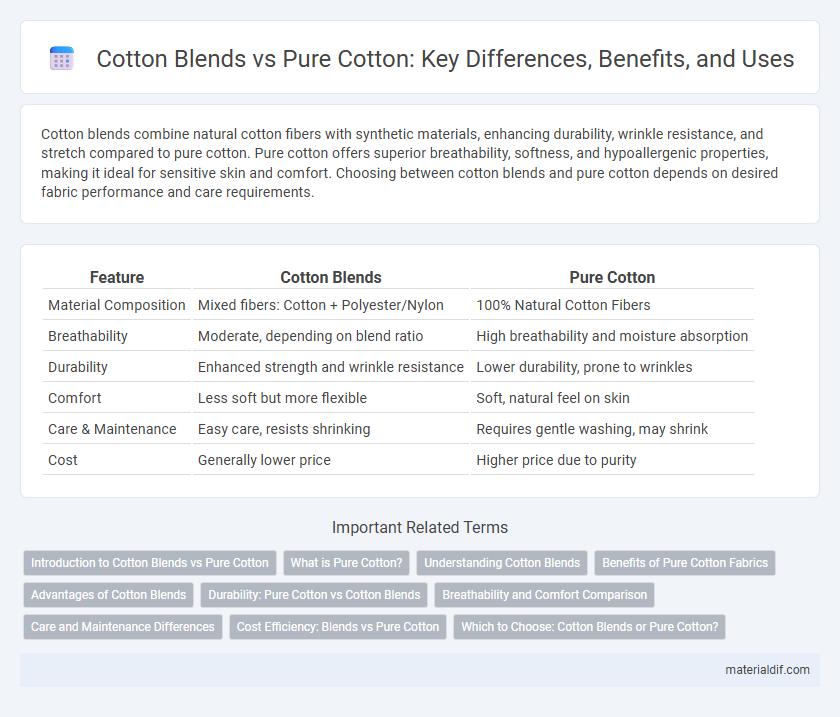Cotton blends combine natural cotton fibers with synthetic materials, enhancing durability, wrinkle resistance, and stretch compared to pure cotton. Pure cotton offers superior breathability, softness, and hypoallergenic properties, making it ideal for sensitive skin and comfort. Choosing between cotton blends and pure cotton depends on desired fabric performance and care requirements.
Table of Comparison
| Feature | Cotton Blends | Pure Cotton |
|---|---|---|
| Material Composition | Mixed fibers: Cotton + Polyester/Nylon | 100% Natural Cotton Fibers |
| Breathability | Moderate, depending on blend ratio | High breathability and moisture absorption |
| Durability | Enhanced strength and wrinkle resistance | Lower durability, prone to wrinkles |
| Comfort | Less soft but more flexible | Soft, natural feel on skin |
| Care & Maintenance | Easy care, resists shrinking | Requires gentle washing, may shrink |
| Cost | Generally lower price | Higher price due to purity |
Introduction to Cotton Blends vs Pure Cotton
Cotton blends combine natural cotton fibers with synthetic materials such as polyester or spandex to enhance durability, wrinkle resistance, and stretchability compared to pure cotton. Pure cotton is prized for its softness, breathability, and hypoallergenic properties but tends to wrinkle and shrink more easily. Blended fabrics offer a balance of comfort and performance, making them suitable for activewear and easy-care clothing.
What is Pure Cotton?
Pure cotton refers to fabric made entirely from natural cotton fibers without any synthetic materials mixed in. This 100% cotton fabric is known for its softness, breathability, and hypoallergenic properties, making it ideal for sensitive skin. Unlike cotton blends, pure cotton provides better moisture absorption and durability, enhancing overall comfort and longevity in textiles.
Understanding Cotton Blends
Cotton blends combine natural cotton fibers with synthetic materials like polyester or spandex to enhance durability, stretch, and wrinkle resistance, making them more versatile than pure cotton. These blends maintain the breathability and softness of cotton while offering improved moisture-wicking and shape retention, ideal for activewear and casual clothing. Understanding cotton blends helps consumers choose fabrics that balance comfort with performance and longevity.
Benefits of Pure Cotton Fabrics
Pure cotton fabrics offer superior breathability and moisture absorption compared to cotton blends, making them ideal for sensitive skin and hot climates. The natural fibers in pure cotton provide enhanced durability and softness, ensuring long-lasting comfort and a luxurious feel. Unlike blended fabrics, pure cotton is hypoallergenic and biodegradable, supporting both user health and environmental sustainability.
Advantages of Cotton Blends
Cotton blends combine natural cotton fibers with synthetic materials like polyester, enhancing durability, wrinkle resistance, and moisture-wicking properties compared to pure cotton. These blends maintain breathability while improving fabric strength, color retention, and faster drying times, making them ideal for activewear and everyday clothing. The fusion reduces shrinkage and increases affordability without compromising comfort, offering practical benefits over 100% cotton garments.
Durability: Pure Cotton vs Cotton Blends
Cotton blends offer enhanced durability compared to pure cotton by combining natural fibers with synthetic materials such as polyester, which increase resistance to wear and tear. Pure cotton, while breathable and soft, tends to weaken and lose shape faster under frequent washing and heavy use due to its natural fiber composition. Choosing cotton blends extends garment lifespan, making them ideal for high-traffic clothing or household textiles requiring greater resilience.
Breathability and Comfort Comparison
Cotton blends often incorporate synthetic fibers like polyester, reducing breathability compared to pure cotton, which allows better air circulation and moisture absorption, enhancing comfort in warm climates. Pure cotton excels in softness and absorbs sweat efficiently, making it ideal for sensitive skin and active wear. However, cotton blends offer increased durability and wrinkle resistance at the cost of reduced natural breathability and comfort levels.
Care and Maintenance Differences
Cotton blends typically require less maintenance than pure cotton due to added synthetic fibers that enhance wrinkle resistance and durability, reducing the need for frequent ironing and careful washing. Pure cotton, being a natural fiber, demands gentler care to avoid shrinkage, fading, and wear, often requiring cold water washes and air drying. Blended fabrics dry faster and are less prone to shrinking, making them more convenient for everyday use and frequent laundering.
Cost Efficiency: Blends vs Pure Cotton
Cotton blends often provide greater cost efficiency compared to pure cotton by combining natural fibers with synthetic ones, reducing overall production expenses while maintaining comfort and durability. Pure cotton tends to be more expensive due to its natural cultivation and processing requirements, resulting in higher retail prices. The choice between blends and pure cotton ultimately influences budget considerations, with blends offering a more affordable option without significantly compromising quality.
Which to Choose: Cotton Blends or Pure Cotton?
Choosing between cotton blends and pure cotton depends on fabric durability, comfort, and cost. Pure cotton offers superior breathability and hypoallergenic properties, ideal for sensitive skin, while cotton blends--often mixed with polyester or spandex--provide increased wrinkle resistance, stretch, and longevity. For everyday wear requiring easy care and durability, cotton blends are advantageous; pure cotton is preferred for luxury textiles demanding natural softness and moisture absorption.
Cotton Blends vs Pure Cotton Infographic

 materialdif.com
materialdif.com